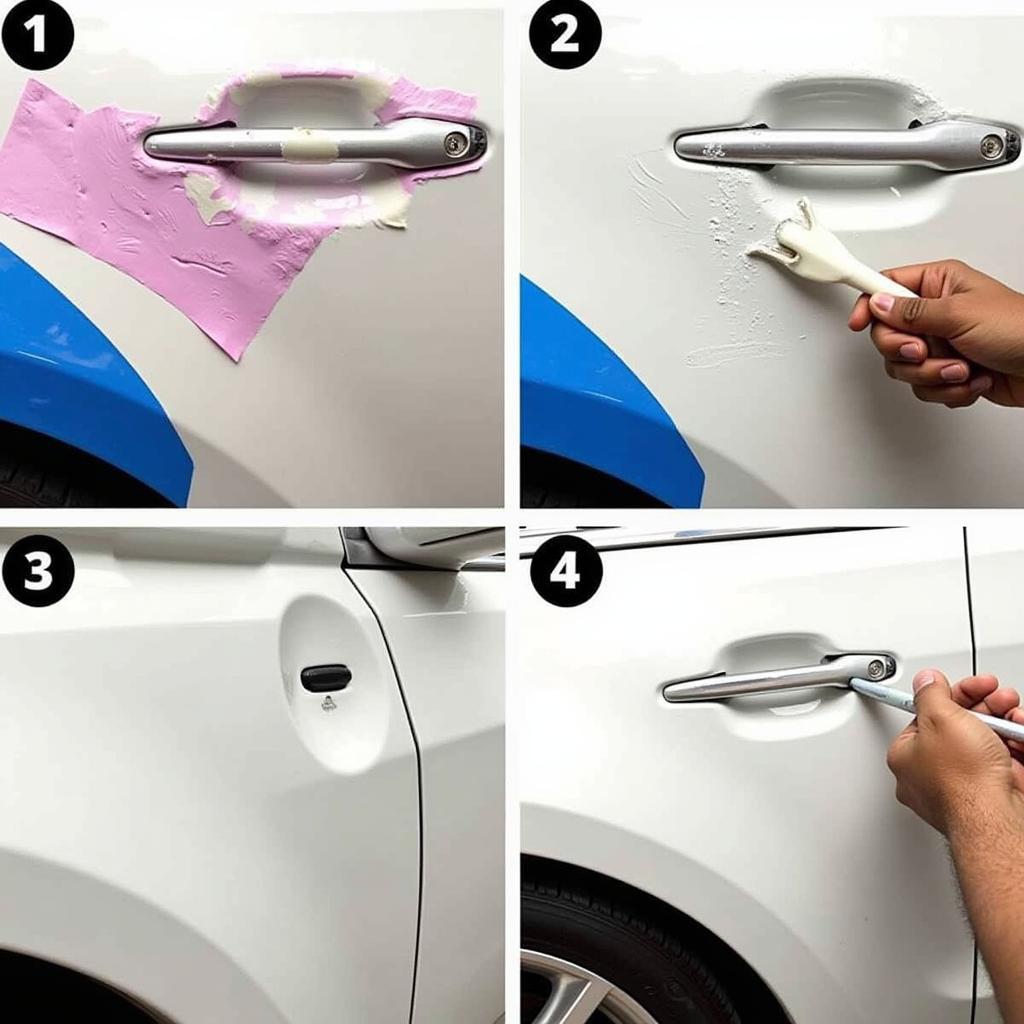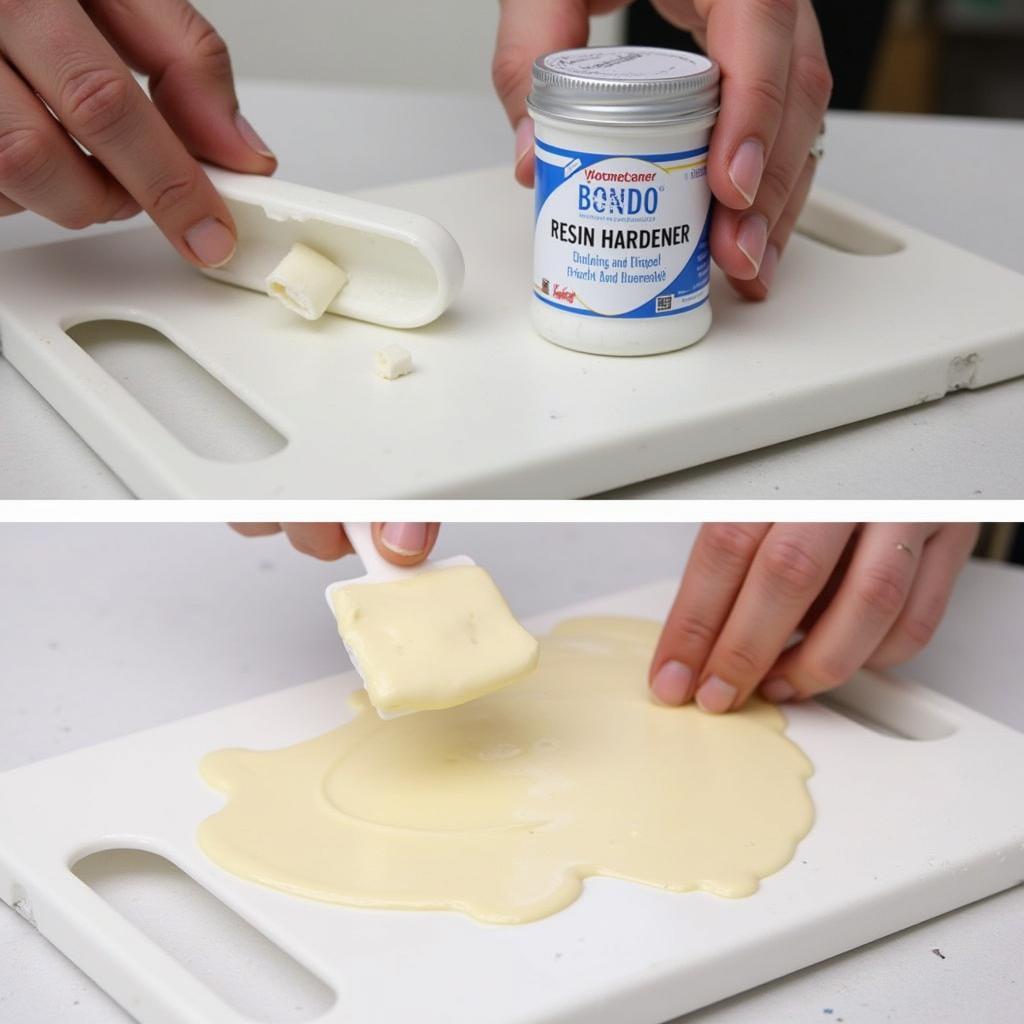Fixing Dents In Car With Bondo is a common practice for DIY auto repair enthusiasts and professionals alike. This guide will walk you through the process, offering tips and tricks for achieving a professional-looking finish. From preparing the surface to sanding and priming, we’ll cover everything you need to know to tackle those pesky dents and get your car looking its best.
Understanding Bondo and Its Applications
Bondo, a brand name for a two-part polyester body filler, is widely used for repairing dents, rust holes, and other imperfections in car bodies. It’s a versatile and relatively easy-to-use material, making it a popular choice for both minor and more substantial repairs. However, using Bondo effectively requires proper preparation and technique. Applying Bondo directly to bare metal isn’t recommended. A good primer is essential for adhesion and preventing rust. Remember, Bondo isn’t a magic bullet. Deep, structural damage requires professional attention. how to fix a car dent with filler provides further insight into filler application for various dent types.
 Applying Bondo to a Car Dent
Applying Bondo to a Car Dent
Preparing the Dent for Bondo Application
Proper surface preparation is crucial for successful Bondo application. Start by cleaning the dented area thoroughly with soap and water, then degrease it with a wax and grease remover. Next, sand the area around the dent with coarse grit sandpaper (80-grit) to remove any loose paint and create a rough surface for the Bondo to adhere to. If rust is present, remove it completely using a wire brush or sandpaper before proceeding. This crucial step ensures the Bondo bonds effectively and minimizes the risk of further rust development. For a more in-depth look at fixing a dented car door, check out this helpful resource: fixing dented car door ody shop.
How to Properly Mix Bondo
Mixing Bondo correctly is essential for achieving the desired consistency and ensuring proper curing. Use a clean mixing board and a plastic spreader. Dispense the appropriate amount of Bondo resin and hardener according to the manufacturer’s instructions. Mix thoroughly until a uniform color is achieved, ensuring no streaks of hardener remain. Work quickly, as Bondo has a limited working time once mixed.
 Mixing Bondo Correctly
Mixing Bondo Correctly
Applying and Shaping the Bondo
Apply the mixed Bondo to the dented area using firm, even strokes, overlapping each pass slightly. Build up the Bondo slightly higher than the surrounding surface to allow for sanding. Allow the Bondo to cure completely according to the manufacturer’s instructions. Once cured, shape the Bondo using a sanding block and progressively finer grits of sandpaper (80-grit, 180-grit, and then 320-grit). Aim for a smooth, even surface that blends seamlessly with the surrounding body panels.
Why Sanding is Key to a Smooth Finish
Sanding is perhaps the most critical step in achieving a professional-looking repair when fixing dents in a car with Bondo. It shapes the filler, blends it seamlessly with the surrounding bodywork, and prepares the surface for priming and painting. Don’t rush this process; patience is key to a flawless finish. If you’re considering DIY repairs, do your own fix dent car door offers practical advice.
Priming and Painting the Repaired Area
After sanding, apply a thin coat of primer to the repaired area. This seals the Bondo, provides a uniform surface for paint adhesion, and helps prevent rust. Once the primer dries, lightly sand it with fine-grit sandpaper (400-grit or higher) to create a smooth surface for the paint. Finally, apply several thin coats of paint, allowing each coat to dry completely before applying the next. Consider a clear coat for added protection and shine.
Conclusion
Fixing dents in car with Bondo is a cost-effective solution for minor body damage. By following these steps and exercising patience, you can achieve professional-looking results and restore your car’s appearance. Remember that proper preparation and technique are key to a successful Bondo repair. Contact us at AutoTipPro for expert advice and assistance. Our phone number is +1 (641) 206-8880, and our office is located at 500 N St Mary’s St, San Antonio, TX 78205, United States.
Have you ever tried fixing a tub with Bondo? You might be surprised at its versatility. Check out fix tub with car bondo. Another common issue car owners face is oil leaks. Find out more about the costs associated with fixing them here: are oil leaks on cars expensive to fix.




Leave a Reply